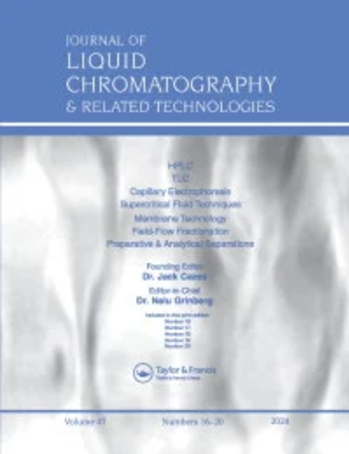Indexation of mixed mode adsorbents using low temperature nitrogen adsorption and Silica-C18 surface energy scale
IF 1.2
4区 化学
Q4 BIOCHEMICAL RESEARCH METHODS
Journal of Liquid Chromatography & Related Technologies
Pub Date : 2021-12-14
DOI:10.1080/10826076.2022.2110117
引用次数: 0
Abstract
Abstract Mixed-mode chromatography is becoming increasingly popular in pharmaceutical and biopharmaceutical applications due to its unique selectivity and retention of a variety of compounds. Mixed-mode chromatography is a chromatographic method in which solutes interact with stationary phase through more than one interaction mode or mechanism. It is because of these complex interactions, however, that it is difficult to predict chromatographic behavior of analytes on mixed-mode columns. Characterization of different mixed-mode columns on the basis of surface energy characteristics has not been explored. In this study, different ratios of porous silica (Axia Luna 5 µm Silica – Phenomenex), and C18 (Axia Luna 5 µm C18 – Phenomenex), single mode adsorbents were blended in various ratios and analyzed by Low Temperature Nitrogen Adsorption (LTNA). A variety of commercially available mixed mode columns were also unpacked and the materials were analyzed by LTNA. Adsorption isotherms, surface area, and BET constants were obtained for all the blended materials in various ratios and the mixed-mode materials. A linear relationship between the BET C-constant and the blend ratio of silica has been observed. The results from the commercial mixed mode packing material showed similar surface energy characteristics to single mode C18 materials. This data suggests that the BET C-constant maybe a viable parameter that can be used to characterize mixed-mode columns on the basis of surface energy. Utilizing this surface energy scale in conjunction with the study of retention behaviors on mixed-mode material could lead to improvements in the understanding of method development on mixed-mode columns, allow the comparison of commercialized mixed-mode columns, and even predict retention behavior of an analyte in mixed-mode columns. Graphical Abstract低温氮吸附和Silica-C18表面能标度对混合模式吸附剂的指数化
摘要混合模式色谱法由于其对多种化合物的独特选择性和保留能力,在制药和生物制药应用中越来越受欢迎。混合模式色谱法是溶质通过多种相互作用模式或机理与固定相相互作用的色谱方法。然而,正是由于这些复杂的相互作用,很难预测分析物在混合模式柱上的色谱行为。基于表面能特性的不同混合模式柱的表征尚未得到探索。在本研究中,不同比例的多孔二氧化硅(Axia Luna 5 µm二氧化硅–Phenomenex)和C18(Axia Luna 5 µm C18–Phenomenex),以不同比例混合单模吸附剂,并通过低温氮吸附(LTNA)进行分析。还打开各种市售的混合模式柱的包装,并通过LTNA分析材料。获得了各种比例的所有混合材料和混合模式材料的吸附等温线、表面积和BET常数。已经观察到BET C常数与二氧化硅的共混比之间的线性关系。商业混合模式填料的结果显示出与单模C18材料相似的表面能特性。该数据表明,BET C常数可能是一个可行的参数,可用于基于表面能表征混合模式柱。将这种表面能尺度与对混合模式材料保留行为的研究结合起来,可以提高对混合模式柱方法开发的理解,允许对商业化的混合模式柱进行比较,甚至可以预测分析物在混合模式柱中的保留行为。图形摘要
本文章由计算机程序翻译,如有差异,请以英文原文为准。
求助全文
约1分钟内获得全文
求助全文
来源期刊
CiteScore
2.80
自引率
0.00%
发文量
29
审稿时长
4.9 months
期刊介绍:
The Journal of Liquid Chromatography & Related Technologies is an internationally acclaimed forum for fast publication of critical, peer reviewed manuscripts dealing with analytical, preparative and process scale liquid chromatography and all of its related technologies, including TLC, capillary electrophoresis, capillary electrochromatography, supercritical fluid chromatography and extraction, field-flow technologies, affinity, and much more. New separation methodologies are added when they are developed. Papers dealing with research and development results, as well as critical reviews of important technologies, are published in the Journal.

 求助内容:
求助内容: 应助结果提醒方式:
应助结果提醒方式:


